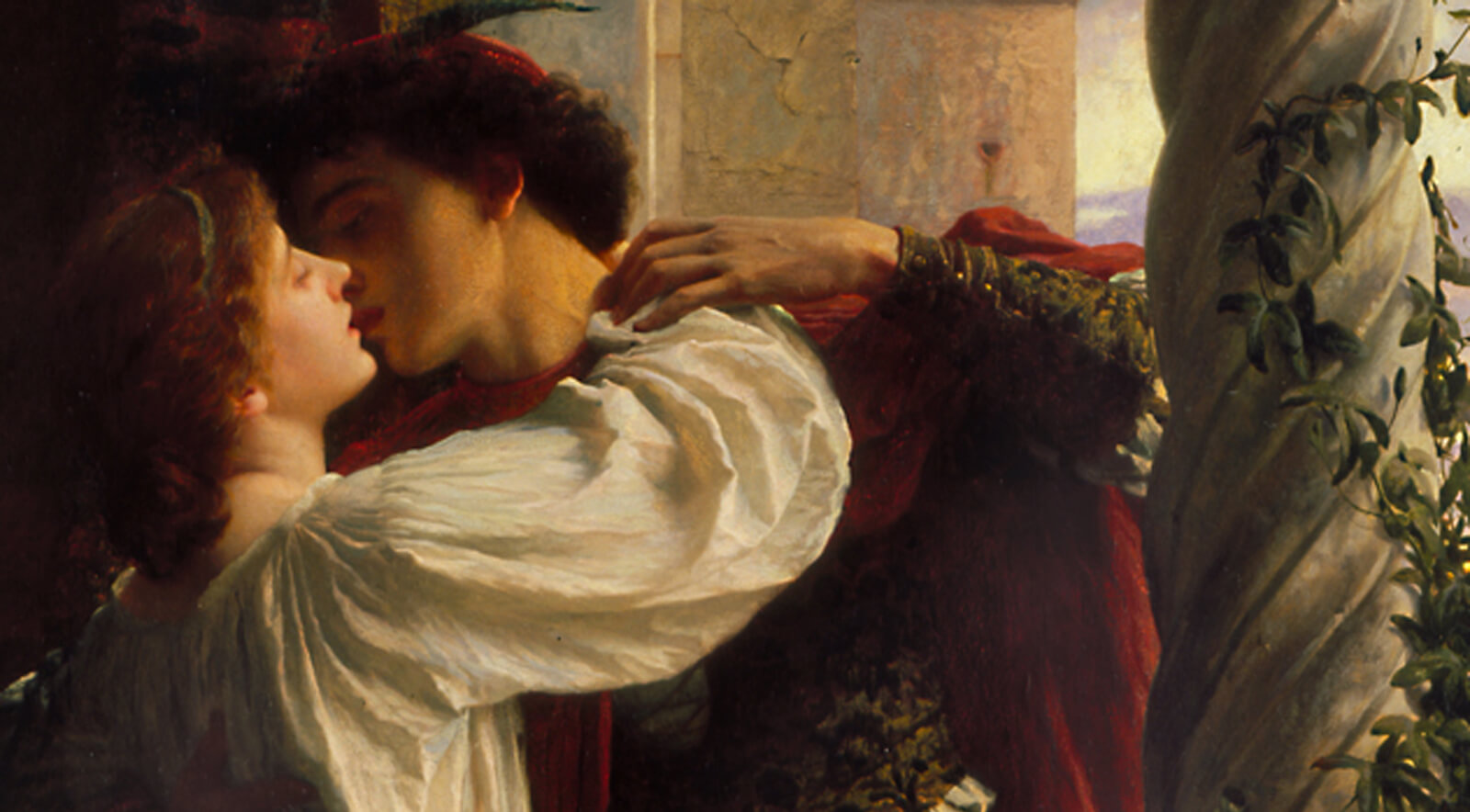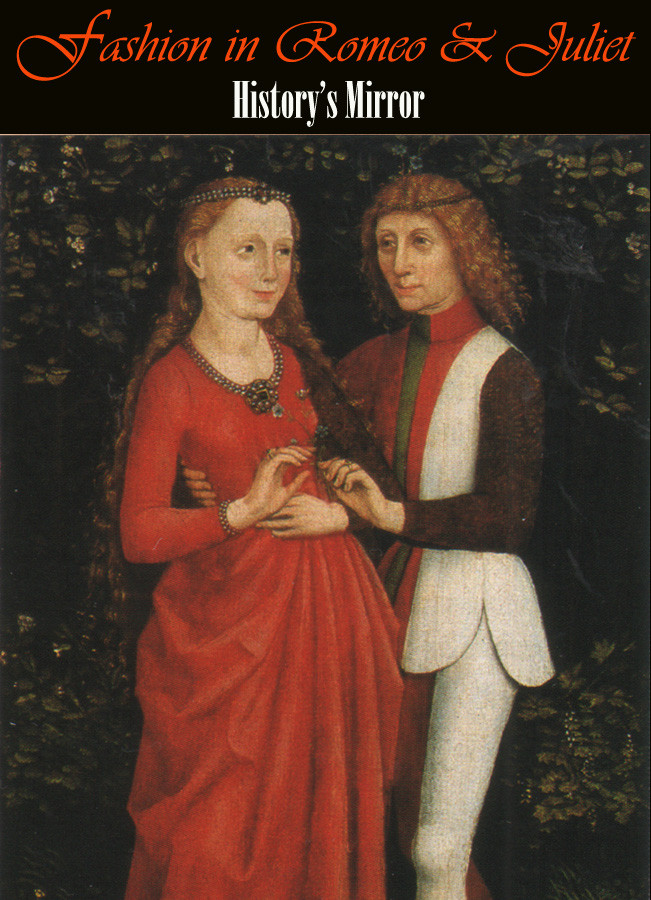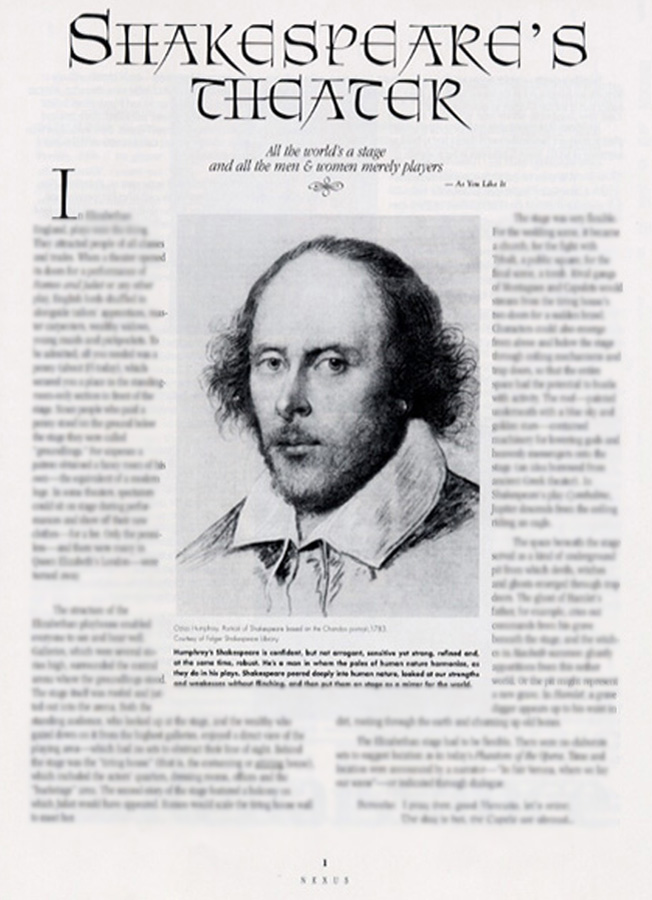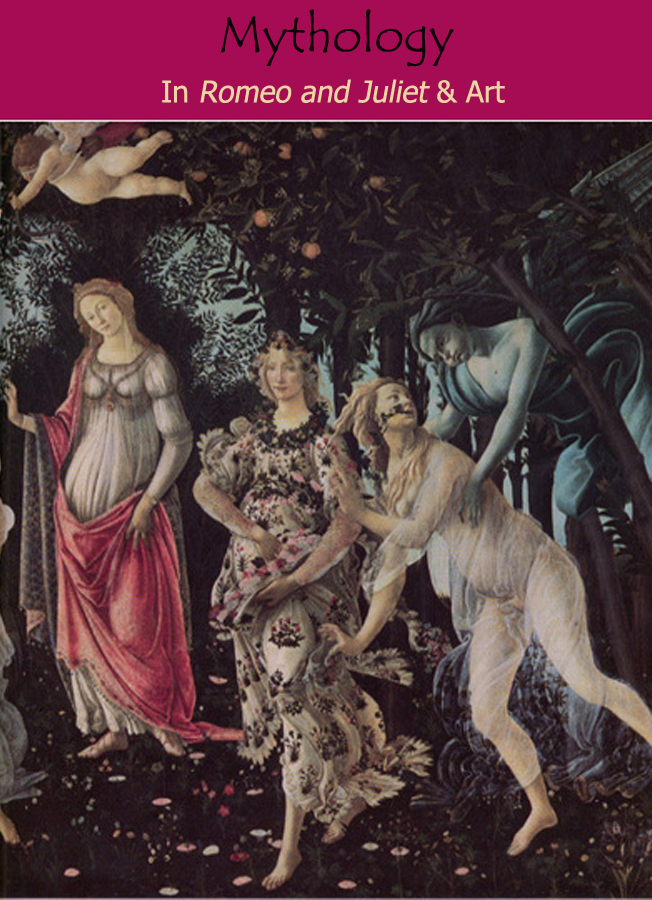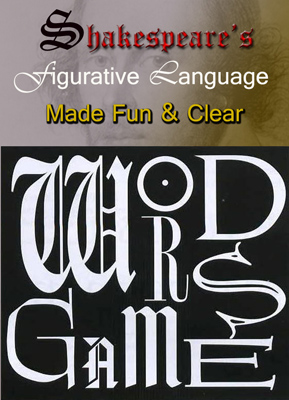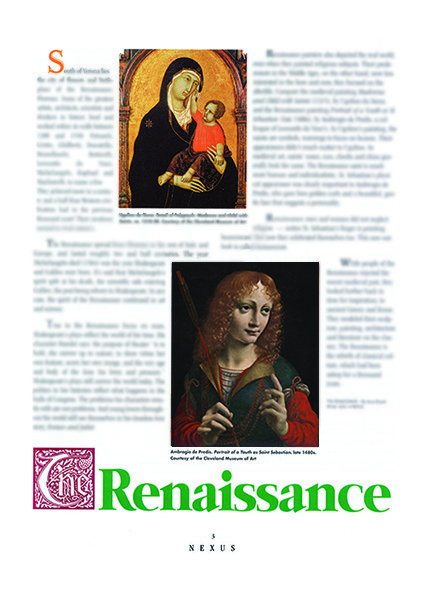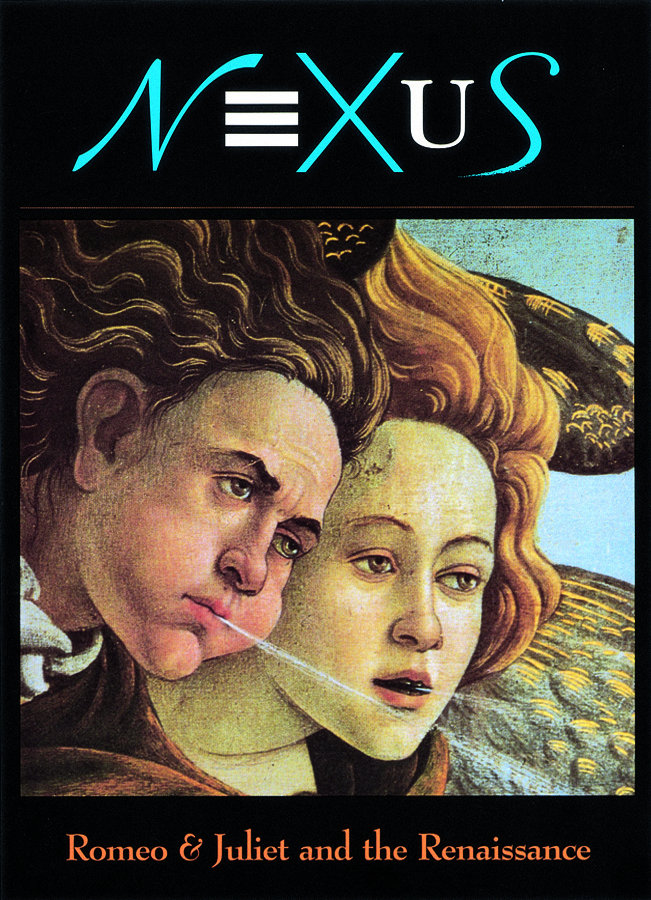Nexus: Romeo and Juliet & the Renaissance
SERVING AMERICAN SECONDARY SCHOOLS FOR 28 YEARS
THE COLLEGE BOARD Review of Romeo and Juliet & the Renaissance
“The materials in this title, wide in scope but nicely detailed, are valuable to any teacher, and…can be used with a variety of period texts. The magazine format is appealing, especially to younger students….All NEXUS volumes emphasize the critical skills and analogical thinking that are crucial for success on the SAT.”
NCAIS North Carolina Association of Independent Schools Newsletter
“NEXUS is a visually exciting, reader friendly magazine with chapters contributed by nationally known experts in their fields. Crisp scholarship, challenging activities, and teacher supplements make learning entertaining and challenging. NEXUS brings the past to life by using a lively writing style and colorful or intriguing anecdotes, and by highlighting the ‘story’ in history.”
CLASSROOM NOTES PLUS, NCTE (National Council of Teachers of English)
“Each [NEXUS] volume…is a hybrid of a well-written interdisciplinary textbook and a lively, attractive magazine.”
LINCOLN-WEST HIGH SCHOOL, Cleveland, OH
“NEXUS is one of the best things I’ve ever seen. You’ve done an exceptional job on the Renaissance.” – Dr. Paulette Goll, English Chair
MAGNIFICAT HIGH SCHOOL, Rocky River, OH
“The kids loved Romeo & Juliet and the Renaissance. It was exciting to watch them make the connections. We had an interdisciplinary week on Galileo and NEXUS fit in perfectly. They started with the Galileo chapters in NEXUS and then used the magazine to explore other interdisciplinary connections. The kids couldn’t stop; they loved finding and making the connections. It was fascinating to see, very very exciting. NEXUS works really well!” – Donna Sheridan, English teacher
APPLETON EAST HIGH SCHOOL, Appleton, WI
“I haven’t seen any better material for connecting the curriculum, especially world literature and world history—and I have a lot of experience connecting the curriculum….You can see the editor has really done his research. His love of the material really shows.” – Michael W. Bergen, Communication Arts Chair
TEMPO, Texas Association for the Gifted & Talented
“With an impressive group of contributors and consultants, Publisher/Editor Jesse Bryant Wilder has put together a stunning set of challenging materials that will provide outstanding learning experiences for secondary students.”
LAND ‘O LAKES HIGH SCHOOL, Land ‘O Lakes, FL
“We’ve received two years of NEXUS subscriptions, and we think they are the most wonderful things that walk the earth! – Katherine Sims, English teacher”
RR. Wilkinson, Home School Teacher, Kittredge, CO
“I am absolutely stunned by the quality of these materials – thank you so much!”
(SEE TEXT SAMPLES IN GREEN BELOW.)
Our Common Core, student friendly Romeo and Juliet figurative language lessons are taught in engaging game formats – making Shakespeare’s language exciting, fun, and accessible without modern translations.
NEXUS Cross-Curricular Connections in each Lesson Deepen Students’ Understanding of both the Play and the Period.
Romeo and Juliet Lesson Plans for Each Subject Area Accompany Class-Set Orders.
CLICK IMAGE TO ENLARGE
Romeo and Juliet Lessons and Lesson Plans Part I – Figurative Language in Literature and Art
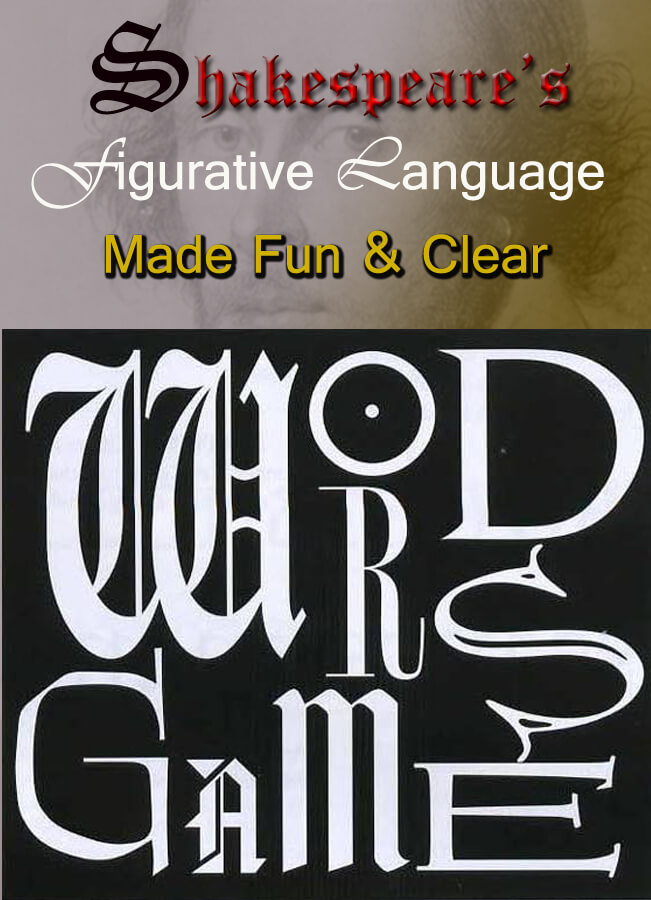
Romeo and Juliet Figurative Language Lessons – 4 Pages
Word Games in Romeo and Juliet: Identifying and Interpreting Similes, Metaphors, Personifications, Irony, Oxymorons, and Antitheses
In this exciting, four-pronged Romeo and Juliet lesson students break down the Bard’s figurative language into frequently used language patterns which are taught as word games – “Pun Ping Pong,” “Word Teeter Totters” (antithesis, oxymorons, and parallelism), etc. This playful approach makes Shakespeare’s language accessible, inspiring, and fun. Students draw inferences from the passage and link Shakespeare’s insights to their own lives. This lesson is aligned with Common Core Standard CSSRL.4 (for GRADES 9-10).
TEXT SAMPLE:
“Word games were probably Shakespeare’s favorite sport. One of the word sports he was a master of is pun ping-pong. In pun ping-pong words are volleyed back and forth between two opponents engaged in a battle of wits. With each volley, the word’s meaning – and sometimes its spelling – changes. When all its meaning twists have been exhausted, the characters continue the game by serving a new word.”
“Romeo and Juliet begins with a pun ping-pong match between Sampson and Gregory, two Capulet servants. To follow this game, the audience (or reader) has to keep his or her eye not on the ball but on the words that are flung back and forth. In Scene 1, the first word to be served is…”
For more on figurative language, see “Word Wars,” Macbeth and the Dark Ages, NEXUS, “Shakespeare and Caesar, Mysteries of the Mind,” Julius Caesar and Ancient Rome, from Republic to Empire, NEXUS, and “Sophocles’ Seesaw” in Antigone and the Greek World, NEXUS.
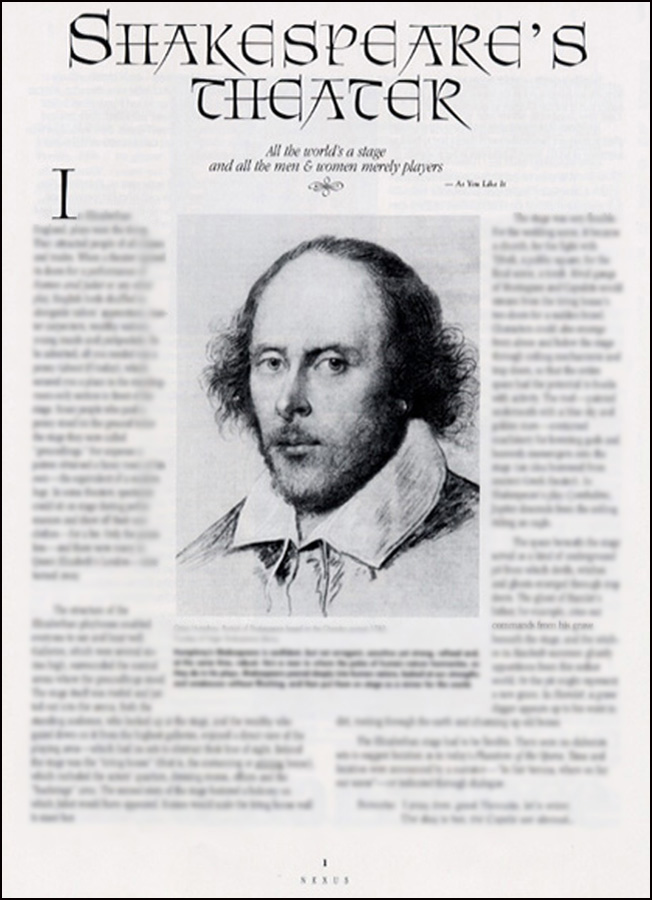
Romeo and Juliet Lesson on the Shakespearean Stage – 2 Pages
This exhilarating introduction to Elizabethan drama brings the Globe Theater to vibrant life. Students feel the pulsating energy and excitement of English Renaissance theater and learn the demands of Shakespeare’s stage. Students learn, for example, that characters needed to represent and argue multiple points of view to engage all classes in the audience, and that playwrights had to rely on language cues to establish time, place, and even temperature – “The day is hot, the Capels are broad…” or “It was the lark….Night’s candles are burnt out.” Aligned with Common Core Standards CSSRL.4, CSSRL.5 and CSSRL.6 (for GRADES 9-10).
TEXT SAMPLE:
“In Elizabethan England, plays were the thing. They attracted people of all classes and trades. When a theater opened its doors for a performance of Romeo and Juliet or any other play, English lords shuffled in alongside tailors’ apprentices, master carpenters, wealthy widows, young maids and pickpockets. To be admitted, all you needed was a penny (about $5 today), which secured you a place in the standing-room-only section in front of the stage. Since people who paid a penny stood on the ground below the stage, they were called ‘groundlings.’ For sixpence a patron obtained a fancy room of his own – the equivalent of a modern loge….The stage was very flexible. For the wedding scene, it became a church; for the fight with Tybalt, a public square; for the final scene, a tomb. Rival gangs of Montagues and Capulets would stream from the tiring house’s two doors for a sudden brawl….Elizabethan actors, too, needed to be flexible. They were surrounded by the audience and had to communicate not only to the people in front of them, but to spectators sitting above, below and behind the stage….Dissatisfied audience members were quick to show their displeasure. Instead of popcorn and soda, Elizabethan audiences consumed hazelnuts and beer. A bad performance might be greeted with a hail of nutshells, or worse. (In France, Renaissance stages were equipped with screens to protect actors from incoming projectiles – tomatoes, eggs, or whatever was handy.) It’s reported that pickpockets nabbed during a performance were tied to the stage while the audience…”
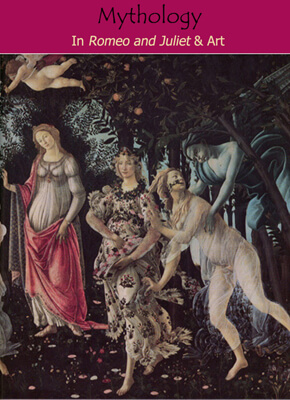
Romeo and Juliet Lessons on Visual Metaphor in Renaissance Art – 4 Pages
IN THESE ROMEO AND JULIET LESSONS STUDENTS IDENTIFY AND INTERPRET VISUAL METAPHORS, CONTRASTS AND SYMBOLS IN FAMOUS RENAISSANCE PAINTINGS, REINFORCING THEIR LITERARY FIGURATIVE-LANGUAGE-INTERPRETATION SKILLS THROUGH VISUAL MEDIA.
Poetry-in-Painting Lesson with Botticelli’s Primavera
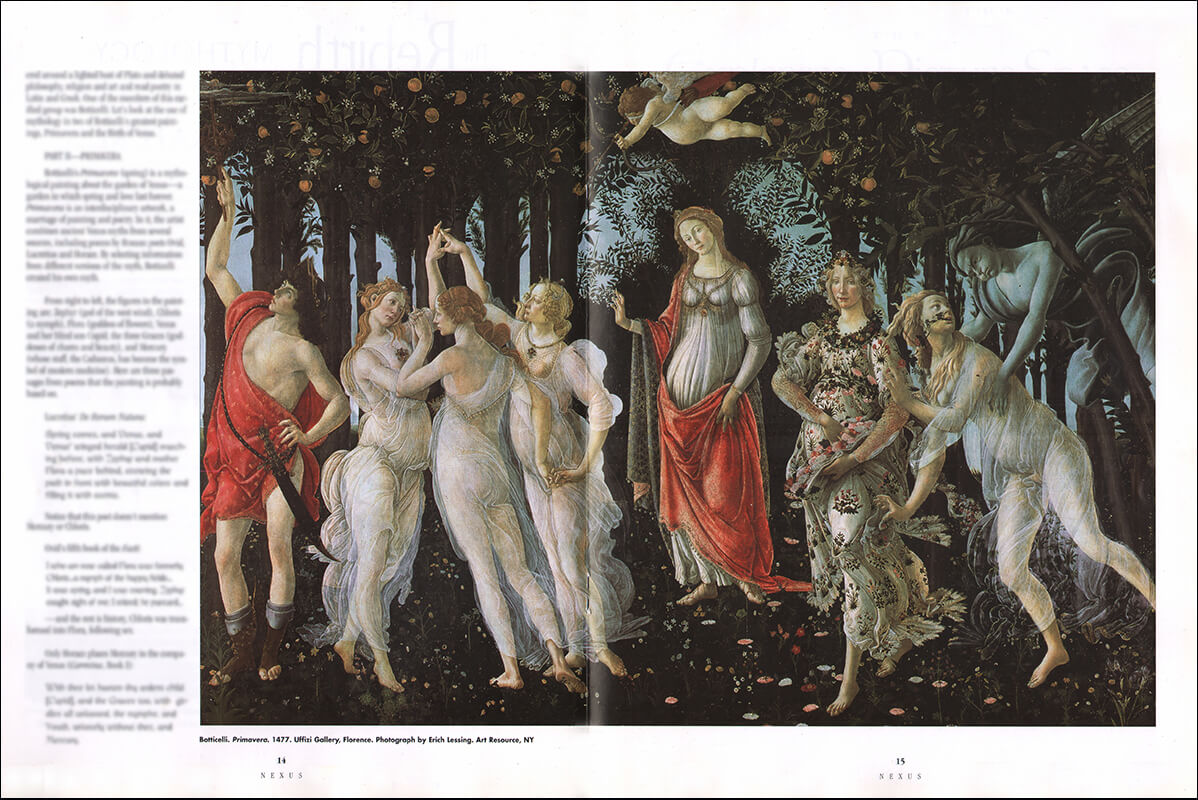
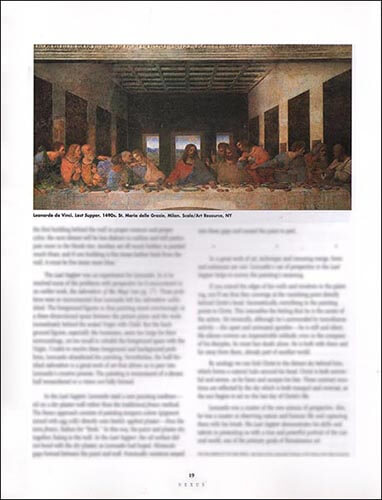
Leonardo Da Vinci Lesson – Reading The Last Supper – 3 Pages
TEXT SAMPLE:
“In 1493, one year after Columbus sailed to the New World, Leonardo da Vinci began work on his Last Supper in the dining hall of a Milanese monastery. It was painted on a wall overlooking the eating tables so the monks of Santa Maria delle Grazie could contemplate it while they ate. But until Leonardo finished the gigantic painting, the monks had to eat in the kitchen or outside. ‘It is said that the Prior of that place kept pressing Leonardo to finish the work,’ wrote Giorgio Vasari in his Lives of the Artists, ‘for it seemed strange to him to see Leonardo sometimes stand half a day at a time, lost in meditation….He would have liked him to go on like the laborers hoeing in his garden, without ever stopping his brush.’ Several years later – the painting still unfinished – the Prior filed a complaint against Leonardo with the Duke of Milan. The Duke sided with the artist; nevertheless, it’s rumored Leonardo got even by using the Prior’s face as his model for Judas.”
“Why did the painting take so long to complete? The prior’s nephew…who studied at the monastery in the 1490s later recalled that “When [Leonardo] was working…”
Romeo and Juliet Lessons and Lesson Plans Part II – The Play’s Backstory Meets Renaissance History
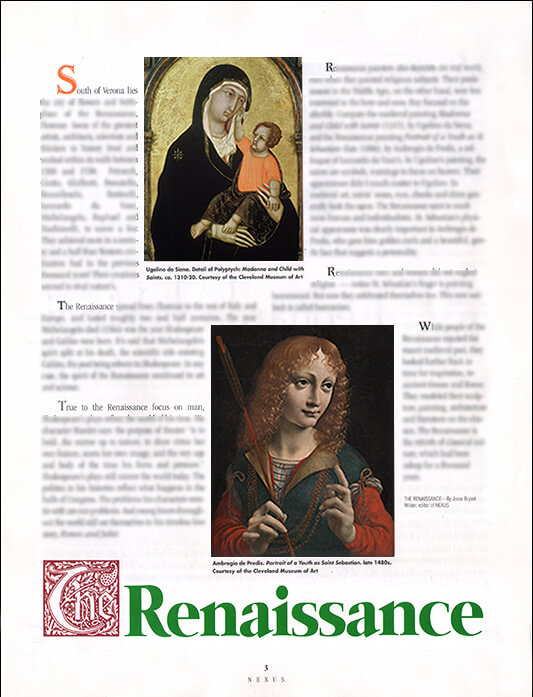
Romeo and Juliet Pre-Reading Lesson: The Renaissance in Literature and Art – 1 Page
In this straight forward, easy-to-read and lively introduction to the period, students examine the birth of the Renaissance in 15th-century Italy and link Renaissance humanism to Shakespeare’s plays in general and Romeo and Juliet in particular and to works of visual art.
TEXT SAMPLE:
“True to the Renaissance focus on man, Shakespeare’s plays reflect the world of his time. His character Hamlet says the purpose of theater ‘is to hold…the mirror up to nature; to show virtue her own feature, scorn her own image, and the very age and body of the time his form and pressure.’ Shakespeare’s plays still mirror the world today. The politics in his history plays reflect what happens in the halls of Congress. The problems his characters wrestle with are our problems. And young lovers throughout the world still see themselves in his timeless love story, Romeo and Juliet…”
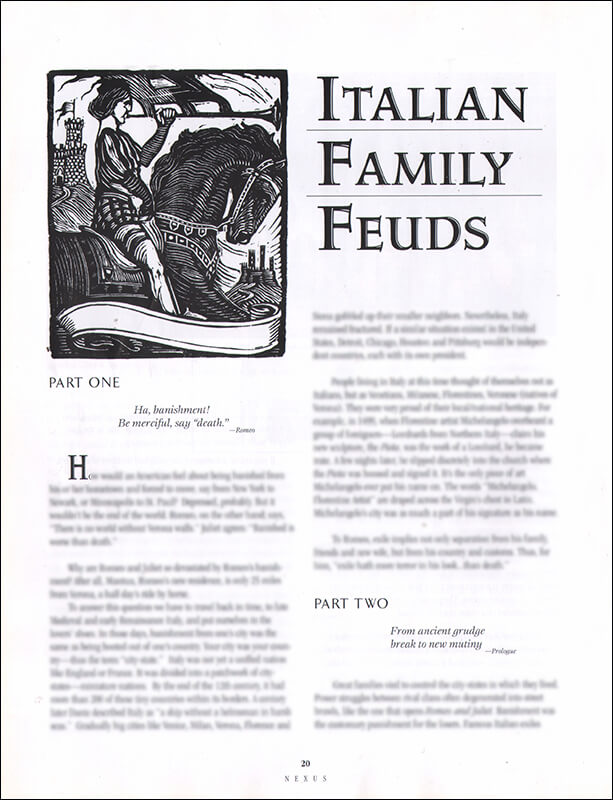
Romeo and Juliet Backstory: Italian Family Feuds – 3 Pages
In this Romeo and Juliet chapter-lesson students learn the backstory of the Capulets (Cappelletti) and Montagues (Montecchi) and explore how the family feud in Romeo and Juliet reflects larger political struggles in late medieval and Renaissance Italy and Europe as it transitioned from feudalism to nationalism. This chapter satisfies Common Core Standards CCSS.ELA-LITERACY.RL.2, RL.3, RL.4, and RL.9 as well as Common Core History/Social Studies Standards CCSS.ELA-LITERACY.RH.1, RH.3, and RH.9 (for 9-10).
TEXT SAMPLE:
“How would an American feel about being banished from his or her hometown and forced to move, say from New York to Newark, or Minneapolis to St. Paul? Depressed, probably. But it wouldn’t be the end of the world. Romeo, on the other hand, says ‘There’s no world without Verona walls.’ Juliet agrees: ‘Banished is worse than death.’ Why are Romeo and Juliet so devastated by Romeo’s banishment? After all, Mantua, Romeo’s new residence, is only about 28 miles from Verona, a half day’s ride by horse. To answer this question we have to travel back in time to late Medieval or early Renaissance Italy and put ourselves in the lovers’ shoes…”
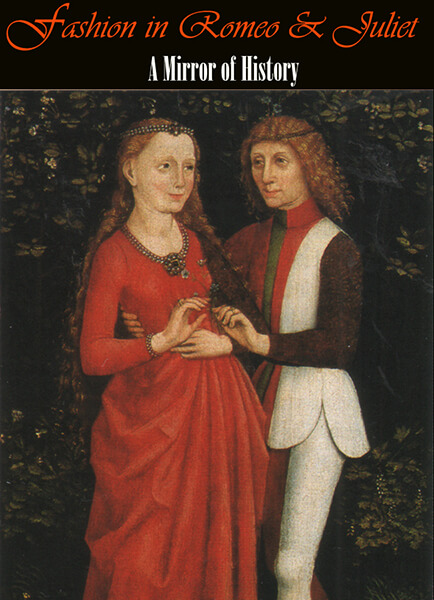
Fashion – The Mirror of History: Mercutio’s Fashion Statements and Romeo’s Outfits – 2 Pages
Students investigate how fashions alluded to in Romeo and Juliet mirror social mores and the class system of the Middle Ages and Renaissance. This Romeo and Juliet chapter-lesson is aligned with Common Core Standard CCSS.ELA-LITERACY.RL.4 and COMMON CORE HISTORY/SOCIAL STUDIES STANDARDS CCSS.ELA-LITERACY.RH.1, RH.4 and RH.6 (for 9-10).
TEXT SAMPLE:
“The morning after the Capulet’s party in Romeo and Juliet, Mercutio greets Romeo with an insult: ‘Bon jour! There’s a French salutation to your French slop.’ He’s referring to the French cut of Romeo’s trousers. (Slop means knee-length, puffy breeches, which were usually worn over tights.) Also, Mercutio is putting down Romeo’s romantic moodiness, which derives from another French tradition called courtly love. What is it about Romeo’s pants that Mercutio doesn’t like? Depending whether the play is set in the 15th or 16th century (Shakespeare didn’t specify), Romeo’s breeches may have been…During both periods, French styles were the thing in Italy (and in England).”
“Acceptance of the human body and a high regard for physical beauty are hallmarks of the Renaissance. Fashion reflected this new attitude with close-fitting clothes designed to highlight the shape….To show off their legs, Renaissance men wore tights. Strong, graceful legs were a sign of male virility and refinement. After meeting Romeo, the Nurse tells Juliet, ‘His leg excels all men’s.’ Maybe Mercutio thinks…”
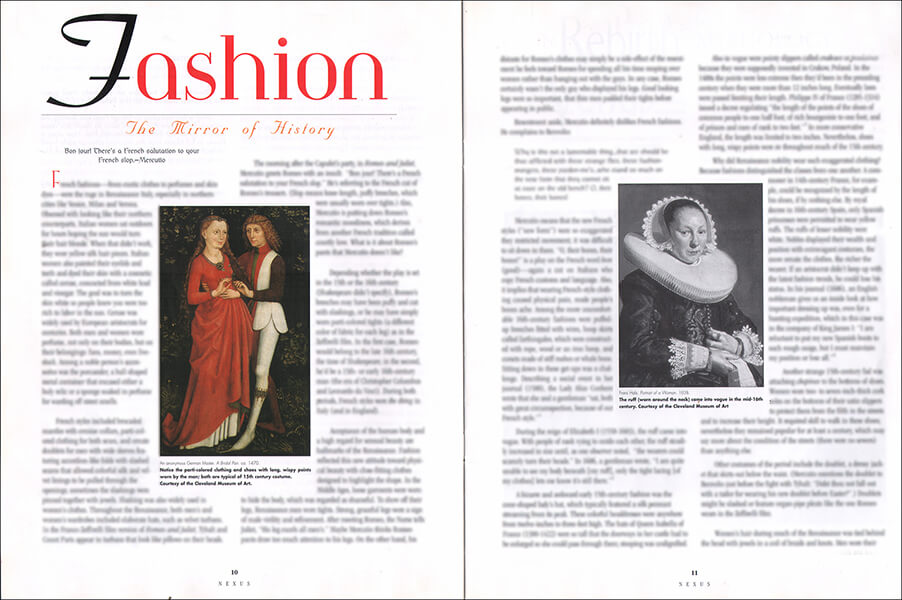
Romeo and Juliet Lessons and Lesson Plans Part III – ANALOGY (the Metaphor of Science) in the Discoveries of Galileo and Leonardo da Vinci
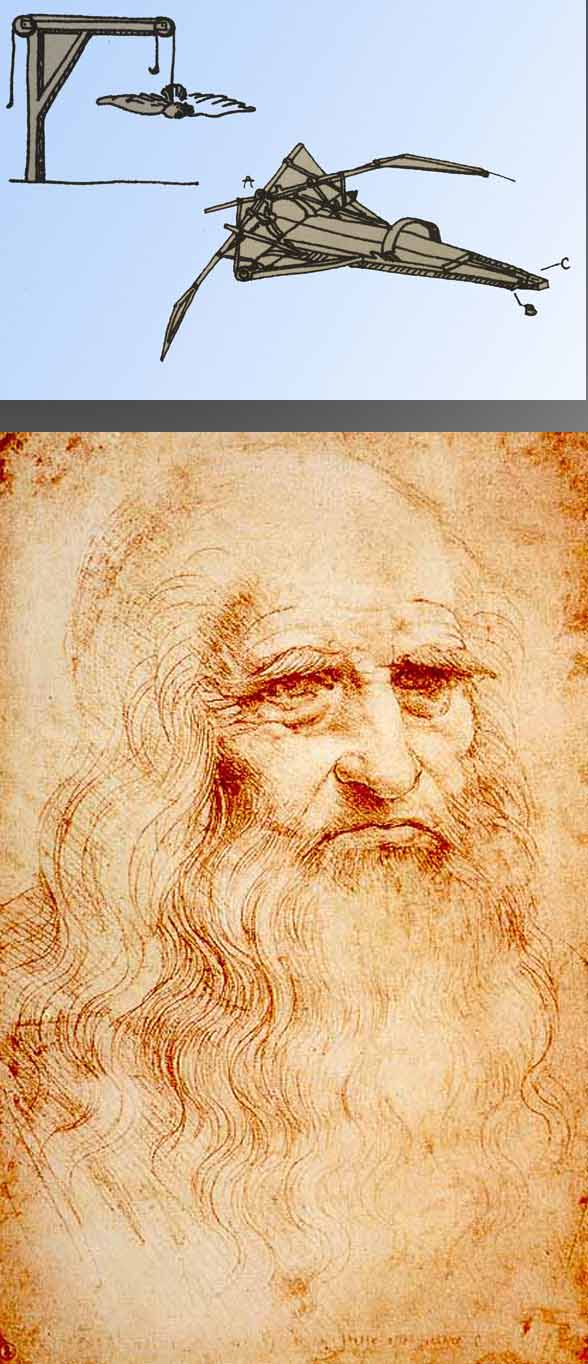
Romeo and Juliet and Leonardo da Vinci Analogical Thinking Lesson: Flying Machines – 2.5 Pages
This lesson examines Leonardo’s use of analogy in making discoveries about flight, for example, “he compared flying to swimming, believing birds use their wings and tail to take advantage of the air in the same way a swimmer uses her arms and legs to stay afloat in water. He wrote: ‘Swimming upon water teaches men how birds [swim] upon the air.’ Leonardo also compared birds to boats. The bird’s tail, he noted, acts like a rudder, helping it to steer. Its wings behave like oars, enabling the bird to drive itself forward. These analogies made many things clear, though they also…” [Also see “Physics of the Crossbow,” The Lion in Winter and the Middle Ages, NEXUS. This physics and history lesson satisfies Common Core Standard CCSS.ELA-LITERACY.RL.1 and CORE SCIENCE and TECHNICAL STANDARDS CCSS.ELA-LITERACY.RST.1 and RST.2, RST.6, RST.7 and RST.8
TEXT SAMPLE:
“Man should not strive to equal the gods, the ancients said. The Greek myths of Icarus and Phaeton (also Phaethon) warn against soaring too high….
“Medieval society bought into this belief. The feudal system and the Church assigned a social niche to high and low alike. If you were a bootmaker, you stayed a bootmaker, and your son became one too. As a rule, you didn’t aim higher. But in the Renaissance, especially in Italy, many people aimed for the stars. They viewed social barriers as challenges to overcome, not limitations. Leonardo da Vinci (1452-1519) was born illegitimate – a major obstacle in those days – yet he surpassed all men of his generation in science and art, and spent his last years living among kings. His experiments on flight were a kind of technological storming of heaven. Through science, he hoped to provide man with wings that would carry him into the domain earlier ages had assigned to the angels. “
“The idea of studying birds and other flying critters, and designing a machine that would imitate them, occurred to Leonardo in the 1480s. In the late 1490s he began to study flight systematically, and around 1505 produced his treatise On the Flight of Birds. He wrote…”
– by Vernard Foley, Associate Professor specializing in the History of Technology and Science, Purdue University and frequent contributor to Scientific American

Galileo Observation/Analogy Lesson – Eye on the Moon – 1 Page
Students step in Galileo’s shoes and, using analogy as he did, reenact his discoveries about the moon, discoveries that helped alter how man regards the universe and his place in it. This lesson aligns with Common Core Standard CCSS.ELA-LITERACY.RL.1 and CORE SCIENCE AND TECHNICAL STANDARDS CCSS.ELA-LITERACY.RST.3, RST.5, RST.7 and RST.8.
TEXT SAMPLE:
“When Galileo first turned his telescope on the Moon this is what he saw: globs of light outside the illuminated crescent with luminous specks between them. As the night passed, the globs grew and began to merge with one another. The specks grew too, into globs, which eventually also merged. More specks appeared. This process continued for a few hours, until suddenly, all the light areas merged with the body of the Moon. Galileo had never seen anything like this before. Or had he?…”
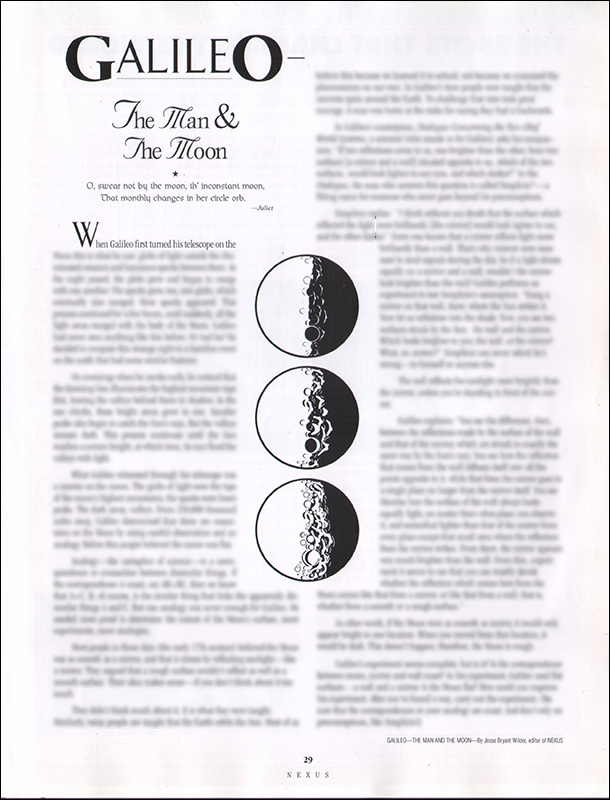
Galileo vs. the Geocentric System (A Lesson in Independent Thinking) – 1 Page
The Spots that Changed Our View of the World.
Students investigate the controversy over sunspots and learn how Galileo’s studies of this solar phenomenon helped prove that the earth and planets revolve around the sun. This chapter aligns with Common Core Standard CCSS.ELA-LITERACY.RL.1 and CORE SCIENCE and TECHNICAL STANDARDS CCSS.ELA-LITERACY.RST.2 and RST.4.
TEXT SAMPLE:
“The year was 1610, and Galileo had just made a startling discovery about the Sun that few of his contemporaries were prepared to accept. Far from being the unchanging beacon celebrated since ancient times as a symbol of constancy, the Sun’s surface turned out to be a stage of lively, sometimes frenzied activity. Galileo observed dark markings slowly parading across the solar disk; later these were appropriately dubbed ‘sunspots.’ The series of dusks during which Galileo observed the Sun proved to be the dawn of modern solar astronomy.”
“Several centuries and a couple hundred thousand sunspots later, astronomers are still tallying these blemishes on the Sun’s surface. Just what are sunspots? First of all, they are not very dark. They appear so only because they are seen against a much brighter background. Isolated from the glaring solar surface and suspended against a dark sky, sunspots blaze with an orange and reddish brilliance rivaling that of the brightest spotlight on Earth. Sunspots are actually comprised of the same material as the rest of the Sun, a seething soup of ionized hydrogen and helium gas. They appear darker (redder) than their brilliant (whitish) surroundings because…”
– by Clyde Simpson, Astronomy Instructor, Cleveland Museum of Natural History, and Observer for the Solar Section of the American Association of Variable Star Observers
Romeo and Juliet Lessons and Lesson Plans Part IV – Patterns and Renaissance Music Lessons
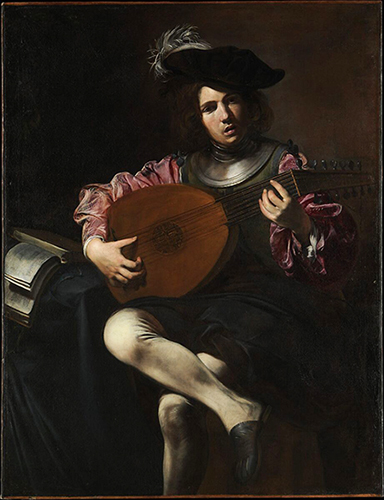
Renaissance Music and Patterns Lesson – 2 Pages
Applying the cross-curriculum thinking skill that we call Pattern Recognition to Renaissance counterpoint, students learn to recognize counterpoint and write it in the manner of Renaissance composers.
For students who cannot read music we provide graphic representations of musical patterns and use “Row, Row, Row Your Boat” as a simple, familiar example of imitative counterpoint. Then we progress to more complex examples of counterpoint in the work of Orlando di Lasso. By the time students have finished this lesson and its accompanying activities, they will be able to write their own compositions using imitative counterpoint and recognize and better appreciate the counterpoint of later musical periods. (For more on counterpoint see “Jelly ‘n Jazz,” The Harlem Renaissance.)
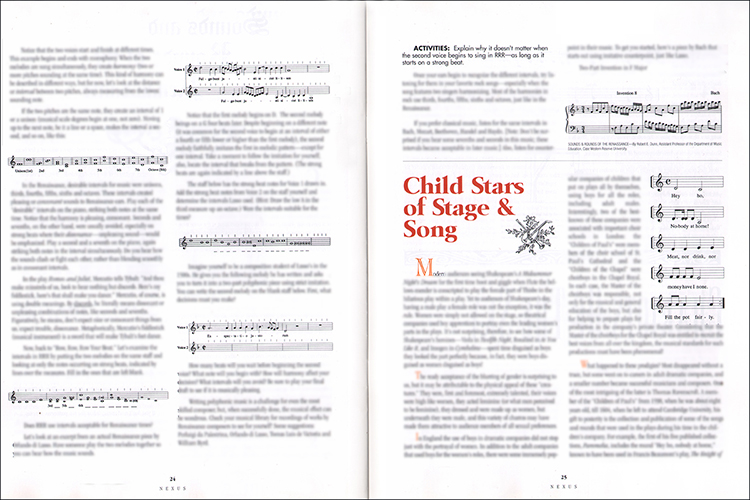
Lesson on Child Stars in Shakespeare’s Plays – 1 Page
This chapter examines the phenomenon of boy actors (many of whom were members of children’s choirs) playing the women’s roles in Shakespeare’s plays. Yes, in Renaissance productions of Romeo and Juliet, Juliet was a boy!
Romeo and Juliet Lesson Plans and Interdisciplinary Support Material
NEXUS Supplements can be accessed under the SUPPLEMENTS menu. NOTE: NEXUS supplements and books are protected by U.S. Copyright and cannot be photocopied, photographed, or downloaded.
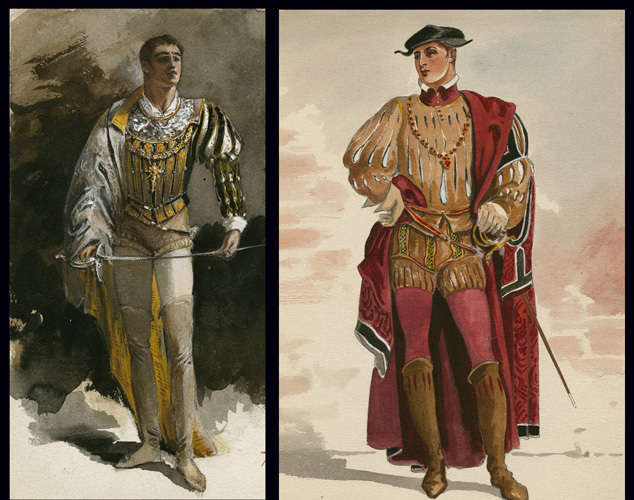
In this Romeo and Juliet supplement-lesson, we examine Mercutio’s disparagement of courtly love conventions (“groaning for love,” “Appear thou in the likeness of a sigh; speak but one rhyme, and I am satisfied! Cry but ‘Ay me!’ pronounce but ‘love’ and ‘dove’), conventions that Romeo adopts wholeheartedly from the era of the Troubadours and Petrarch. (For more on courtly love see “Courtly Love – An Attitude Toward Women,” “The Love Poets (Troubadours),” and “Troubadours of Rock” in The Lion in Winter and the Middle Ages, NEXUS). This supplement and lesson is aligned with Common Core Standards CCSS.ELA-LITERACY.RL.1, RL.2 and RL.4 (for 9-10).
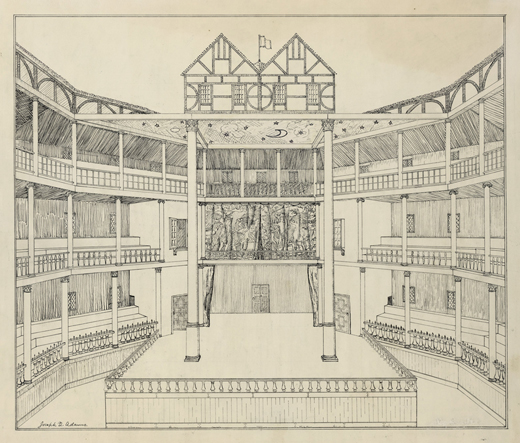
In this brief Romeo and Juliet supplement-lesson students learn about the development of English theater from Mystery and Morality plays to the various types of Elizabethan drama: tragedy, comedy, and history – and the combinations of these mocked in Hamlet. Students are also introduced to the itinerant companies of players that Shakespeare would have seen as a boy touring Stratford-upon-Avon, like the players in Hamlet.
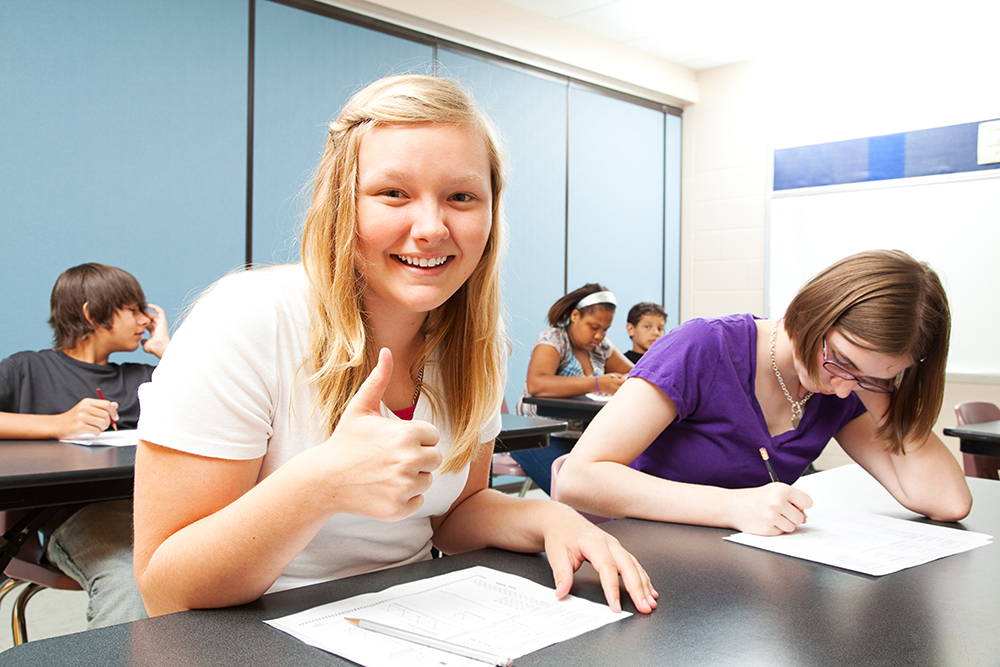
For Romeo and Juliet Lesson Plans see LESSONS menu
Romeo and Juliet vocabulary exercises and quizzes, plot quizzes and tests will soon be available.
GUIDELINES: The NEXUS guidelines suggest interdisciplinary activities, additional lessons in five subject areas, and student-friendly ancillary readings.
NEXUS is a 501(c)(3) nonprofit based in Cleveland, OH. Our mission is to provide schools with outstanding interdisciplinary resources that inspire students to THINK, LINK and IMAGINE
A portion of our proceeds is donated annually to UNICEF’S Audrey Hepburn All Children in School Fund.

